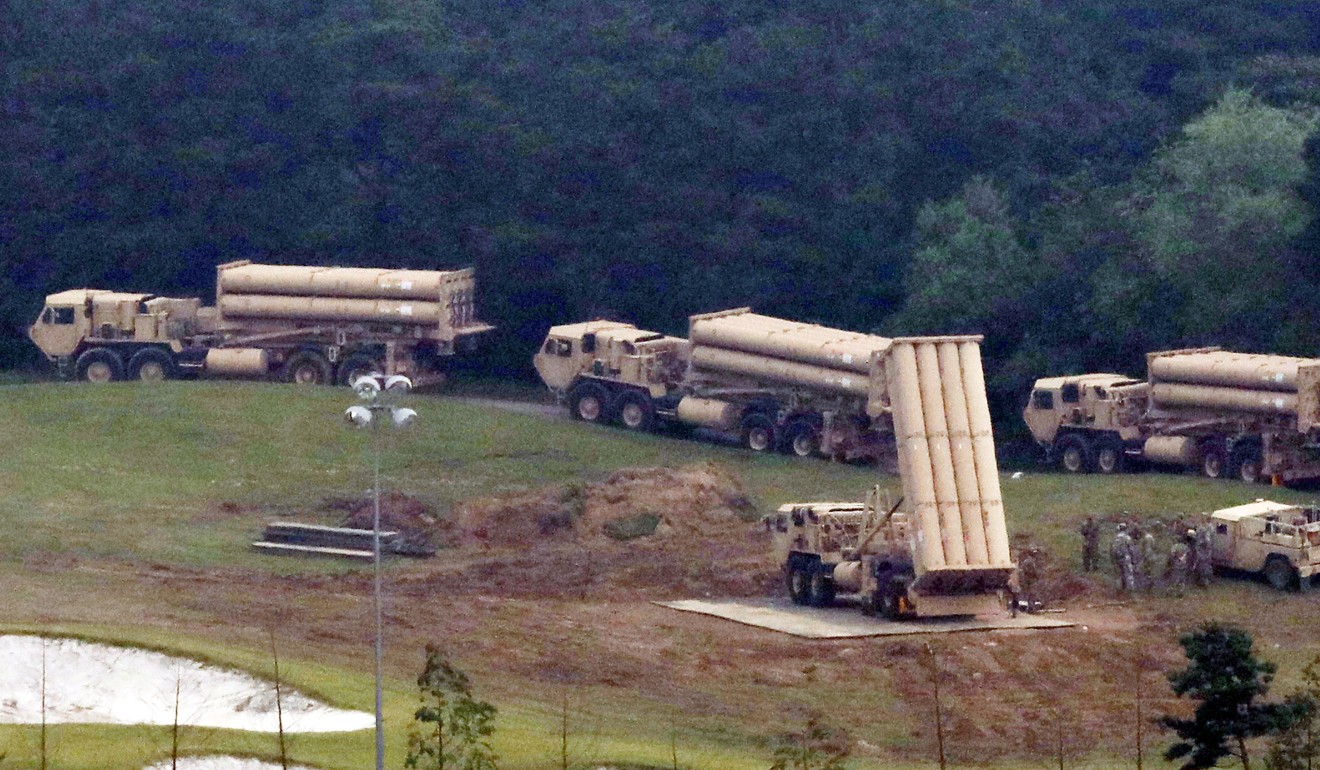
Why South Korea’s promises on THAAD and a US-Japan alliance are so important to China
Beijing can breathe a little easier as fears of a ‘mini Nato’ in Asia wane with Seoul’s latest defence assurances
When the announcement came last week it took some of the air out of a diplomatic and economic feud that had dragged on for more than a year and hit the bottom lines of South Korean companies doing business in China.
The row was triggered by South Korea’s decision to deploy a mobile US anti-missile network called THAAD – the Terminal High Altitude Area Defence system. Seoul rolled out the sophisticated radar and interceptor missiles on a former golf course in September to fend off threats from North Korea’s nuclear and missile programmes.
In response, China tightened the economic screws on its neighbour, boycotting South Korean entertainment products and banning Chinese tour groups from visiting the country.
US ‘moving forward’ with THAAD deployment in South Korea as North Korean crisis grows
But China’s biggest worry was that THAAD would move the US, South Korea and Japan one step closer to a Nato-like regional alliance, and eventually create a “mini Asian version of Nato” to counter China, according to retired Chinese army colonel Yue Gang.
“China is desperately trying to avoid this because the military threat then would be much more than just a ballistic missile defence system,” he said.

Those tensions ebbed on Tuesday after the two nations said they decided to push for further development of their strategic cooperative partnership.
In a parliamentary hearing on Monday, South Korean foreign minister Kang Kyung-wha said Seoul was not considering additional THAAD deployments and would not join the US-led missile defence system.
“China has many concerns and the major one is South Korea joining a trilateral alliance,” Beijing-based military analyst Zhou Chenming said.
The much sought-after announcement last week lowers the prospect of such a compact, giving China some temporary relief.
BEYOND THAAD: THE REAL REASON WHY CHINA IS ANGRY WITH SOUTH KOREA
THAAD is just one component of Washington’s planned ballistic missile defence (BMD) system in the Asia-Pacific. The integrated system would be designed to spot and shoot down any missile aimed at the US or its overseas bases. According to the US Department of Defence, it would comprise various land and ship-based radar and interceptor missiles.
Japan has been the most enthusiastic participant in the US’ plans in the region, deploying long-range AN/TPY-2 X-band radars, ship-based Aegis tracking systems equipped with SM-3 interceptors, and ground-to-air PAC-3 interceptor missiles. It is also planning to install a land-based version of Aegis instead of THAAD.
But South Korea has resisted cross-national integration of the BMD system because of its desire for more strategic autonomy, its reluctance to irritate China and its long-standing disinclination to work with Japan, according to a 2015 US Congressional Research Service report.
China-US mistrust over THAAD a ‘military relations failure’, US defence official says
At the same time, South Korea is moving ahead with its own Korean Air and Missile Defence System (KAMD), which also uses PAC-3s.
Zhou said that so far the South Korean system had not been linked to THAAD or the broader US-led network.
“South Korea has promised not to connect, and if they do connect China will be able to detect it,” Zhou said.
Zhao Tong, a nuclear policy specialist at the Carnegie-Tsinghua Centre for Global Policy, said Seoul’s commitment not to do so probably meant South Korea would avoid setting up a fully interoperable system.
“But to a certain extent the KAMD has to share data with the BMD to be able to work effectively,” Zhao said.
The real reason the US hasn’t tried to shoot down a North Korean missile
China’s major beef with the THAAD system is its powerful X-band mobile radars, which could keep an eye on Chinese military activities in the country’s eastern territory and waters.
Xu Guangyu, a senior researcher at the China Arms Control and Disarmament Association, said the X-band radars had a range of up to 4,000km, putting China and Russia within sight.
“This would mean that all land and air weapons drills would be exposed, and the frequency and quantity of flights as well as the locations of military airports would be known,” Xu said.
Renmin University nuclear analyst Wu Riqiang has written that Beijing is also concerned that THAAD radars would be able to gather information about China’s decoy and real warheads during testing.
South Korea installs four more US THAAD launchers to counter missile threat from North
This data could affect China’s nuclear deterrence because the US military would be able to use the information to identify a decoy during a strategic attack by China – something China would regard as a “red line”.
But Zhao said the US-led ballistic missile defence system would not be a big threat to China’s longer-range missiles. Instead it would be more of an attempt to undermine China’s conventional intermediate or short-range weapons aimed at places such as Taiwan and the East and South China seas.
China ready to neutralise THAAD, retired PLA general says
In the meantime, South Korea has shared intelligence on North Korea’s nuclear and missile programmes with the US and Japan, and the installation of THAAD means the US will have more information about China’s missile development than before.

